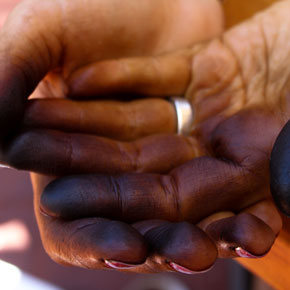If you don’t know your nuts, then you may not know that there are nuts that are actually described as creamy. Macadamia nuts are described as one of those creamy nuts and quite delicious it is. Grown on tall trees– and often harvested straight from the tree– macadamia nuts are indigenous to Australia and are also known as Queensland nut, bush nut, maroochi nut, bauple nut and Hawaii nut.
Macadamia nuts require some effort– much like that of the black walnut but less so. They are often plucked from trees in their green or black casing. The key to successful macadamia nut-cracking is this: they must be dried out. After picking from trees, these nuts need to be stored in cloth for weeks until the outer husk begins to crack (store securely to avoid critters). Once this cracking begins to occur, the outer shell is easy to remove. You are left with a smooth macadamia seed.

The green husk has to dry completely until it cracks. Then, the nut seed shown on the left is ready for cracking.
The hardest part is done. Once you are down to the “seed” level, your macadamia nuts are ready to crack. We recommend the Master Cracker or the Get Crackin’ for this job. The Kenkel Cracker is another great choice. For those of you with large quantities of macadamia nuts, definitely consider the Drill Cracker. It will crack a 5 gallon bucket is 5-7 minutes. All of these crackers are quality, American-made products.
Macadamia nuts have loads of healthy benefits and are great as a stand-alone snack or in a recipe such as fudge or cookies. If you have any great recipes, forward them over to us and the best will be featured here. Til next time!









